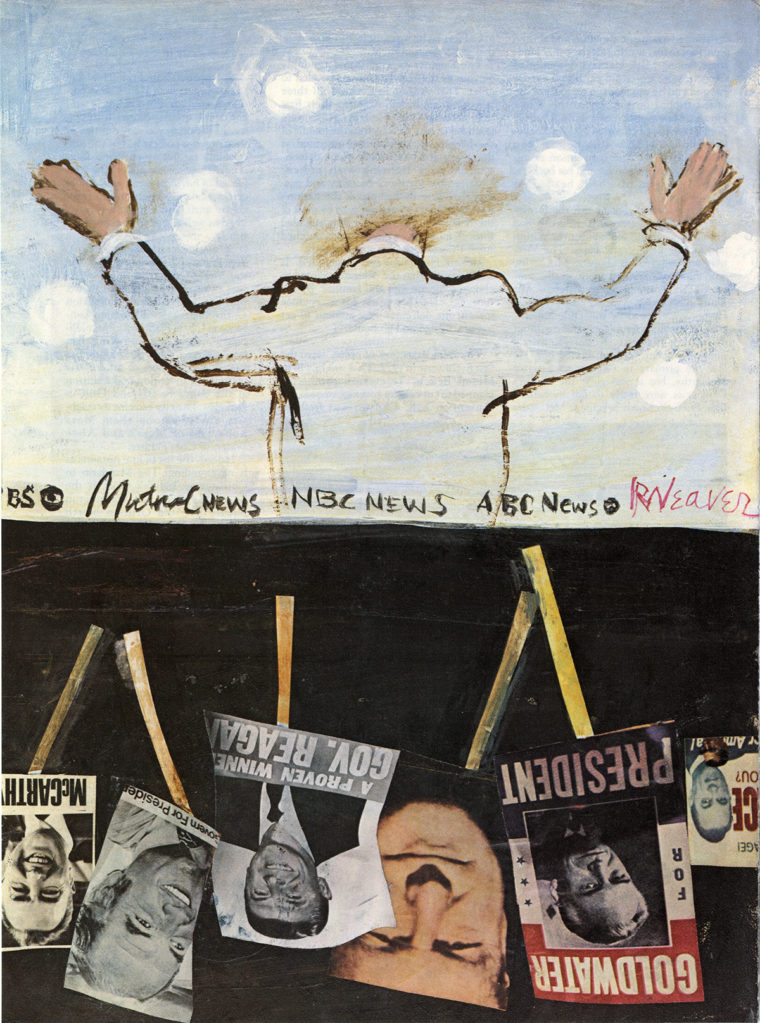Robert Weaver Collection
This collection includes original artwork in various formats and published material by Robert Weaver mainly dating between the 1950s and the 1970s.
Dates
- Creation: circa 1950-1980
- Other: Date acquired: 00/00/2004
Conditions Governing Access
There are no restrictions to access.
Conditions Governing Use
Users of the collection must read and agree to abide by the rules and procedures set forth in the Materials Use Policies.
Providing access to materials does not constitute permission to publish or otherwise authorize use. All publication not covered by fair use or other exceptions is restricted to those who have permission of the copyright holder, which may or may not be Washington University.
If you wish to publish or license Special Collections materials, please contact Special Collections to inquire about copyright status at (314) 935-5495 or spec@wumail.wustl.edu. (Publish means quotation in whole or in part in seminar or term papers, theses or dissertations, journal articles, monographs, books, digital forms, photographs, images, dramatic presentations, transcriptions, or any other form prepared for a limited or general public.)
Extent
80.50 linear feet
Biographical or Historical Information
Beginning in the 1950s, Robert Weaver epitomized a socially engaged approach to commercial illustration, drawing the human drama from the immediacy of life. By integrating formal and conceptual currents from fine art practices, he altered the practice’s methodologies thus dramatically expanding its possibilities.
Weaver was born in 1924, in Pittsburgh, Pennsylvania. He studied at the Carnegie Institute, the Art Student’s League in New York, and the Accademia delle Belle Arti in Venice. He began his career in New York in 1952 and over the next three decades, his work appeared in Esquire, Fortune, Life, Look, Playboy, Seventeen, Sports Illustrated, and TV Guide, among many other publications. Weaver’s emphasis on expressionistic, bravura paint-handling wed with unstable narrative content moved the goals of illustration away from depicting an expected point of heightened drama, “to violate the sense of natural relationships,” as he put it. His was an art that flaunted subjectivity, a “visual journalism” truer to life than the compositional niceties and slick brushwork of the generation preceding.
With his bold line always dominant, and a focus on the lively urban landscape, Weaver left the process visible, reflecting his commitment to manifesting on the page the changing cultural climate. He stressed the importance of drawing life, from life, guided by a precisely rendered political conscience and incorporating collage elements that literally brought the physical world into his charged psychological space. Crucially, by fragmenting the image area he introduced multiple viewpoints and jagged sequential narrative into a traditionally fixed point of view, representing a cerebral approach to an illustration world in flux.
In addition to his magazine work, Weaver illustrated numerous books and record industry advertising campaigns. He was the recipient of numerous awards from The Society of Illustrators, which elected him into their Hall of Fame in 1985, and the Art Director’s Clubs of New York and Philadelphia. His work was the subject of the posthumous retrospective, “Seeing is Not Believing: The Art of Robert Weaver” at the Norman Rockwell Museum in 1997.
Weaver was a visiting faculty member at Syracuse University and taught at the School of Visual Arts in New York for more than thirty years, co-creating their Illustration as Visual Essay program. His teaching legacy was such that a 1997 issue of Drawing SVA was devoted to his memory, giving his former students the opportunity to reflect on his profound influence as an educator.
Sources
“Pioneers: Robert Weaver.” Communication Arts, May/June (2000): 106–9.
Reed, Walt. “Robert Weaver.” In The Illustrator in America, 1860-2000, 363. New York: The Society of Illustrators, 2001.
Note written by
Arrangement Note
Items are arranged by art medium and material type. The collection is divided into 13 series as follows: Series 1: Original Art: graphite on paper Series 2: Original Art: graphite on board Series 3: Original Art: collage binders Series 4: Original Art: paintings on paper Series 5: Original Art: paintings on board Series 6: Original Art: paintings on canvas Series 7: Original Art: pastels on paper and board Series 8: Original Art: mixed media Series 9: Original Art: shadow box collages Series 10: Published Materials: tear sheets Series 11: Published Materials: other material types Series 12: Published Materials: projects Series 13: Personal Papers
Method of Acquisition
The collection was donated to University Archives by Robert Weaver's daughter Antonia Weaver Pelaez and by his brothers Daniel Weaver and Fritz Weaver in 2004 and 2007. It was later transferred to the Modern Graphic History Library.
Accruals and Additions
Accruals are interfiled within the collection.
Processing Information
The collection was processed by Washington University Department Special Collections Staff 2005, October 2007, and 2008. Item-level inventory was added by Jolie Braun in May 2012.
- Title
- Robert Weaver Collection
- Author
- Special Collections Staff
- Date
- 00/00/2008
- Description rules
- dacs
- Language of description
- eng
Revision Statements
- 09099999: This finding aid was entered into Archon by Jolie Braun in July 2012.
Collecting Area Details
Part of the Dowd Illustration Research Archive Collecting Area
Andrea Degener, Interim Curator
West Campus Library
7425 Forsyth Blvd
Clayton MO 63105 US
(314) 935-5495
spec@wumail.wustl.edu
